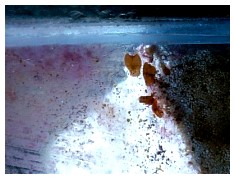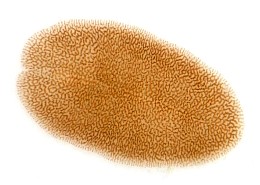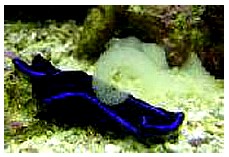 2009
2009  September 2009
September 2009  Flatworms and Other "Bugs" That Make You See Red
Flatworms and Other "Bugs" That Make You See Red
Stats:
 | Today | 860 |
 | Yesterday | 5613 |
 | This week | 11581 |
 | Last week | 53781 |
 | This month | 860 |
 | Last month | 199251 |
 | All days | 33797309 |
Your IP: 13.58.138.232
Mozilla 5.0,
Today: Apr 01, 2025
Flatworms and Other "Bugs" That Make You See Red
Introduction
This month’s featured fish is the Melanarus wrasse, which is reported to be a biological control for flatworms infesting marine corals. In this article I will attempt to spell out exactly what flatworms are, and how they can kill marine corals. I’ll also touch on some of the confusion that surrounds the commonly used term “redbugs.”
Worms in General
Worms are a common name for many organisms, but in general, they have three main phylum, namely: Nematode (nematodes and other roundworms), Annelid (earthworms, bristle worms and other segmented worms) and Platyhelminthes (flatworms). Today there are other phylum classified as worms, but the three mentioned are the main groups. The Platyhelminthes are a very large group unto themselves and one sub-group, the class Turbellaria, contains over 4500 species and includes the flatworms discussed in this article. Flatworms are very simple organisms and lack respiratory or circulatory systems. Their flattened shape helps overcome this lack of a respiratory system as it allows diffusion of oxygen and carbon dioxide directly through their body tissues. One group of Turbellaria is the primitive Acoela flatworms that do not have a digestive system as well. Many groups of flatworms are parasitic in nature, and some are major pathogens of domestic animals and humans. The Turbellarian Polyclad flatworms tend to be more predatory than parasitic, and those that create problems for corals typically fall into that group.
Redworms
|
|
| Red Planaria, Convolutriloba retrogemma. Photo courtesy of Cory Walker. |
The Acoel flatworms, of which the genus Convolutriloba is a member, are often blamed for coral attacks. Convolutriloba retrogemma is the species of flatworm most often called by the common name of “redbugs” or “red planaria,” but there are probably several species involved. They are tiny, about one-eighth inch long, reddish-brown flatworms. They contain endosymbiotic algae that help provide them with some nutrition. This brown alga, along with their reddish-colored rhabdoid gland, imparts a hue that appears reddish brown to rust under the high Kelvin temperature lights used in most marine aquaria. They do not eat coral but rather small invertebrates such as copepods and rotifers present in the tank. They breed rapidly and reproduce either sexually, laying eggs or by the asexual processes of fission or budding where the worm simply splits up, producing a bud that forms a new worm. Therein lies the problem: the flatworms crawl along the coral in search of food and, as they rapidly multiply, they block the coral's light as well as hamper nematocyst capture of the coral’s prey. The coral is thus deprived of symbiotic nutrient nourishment, as well as planktonic food, and slowly starves to death.
An overlooked danger of flatworms is that some have chemical defenses to ward off predators. These range from foul tasting terpenes to full-fledged neurotoxins. While alive these toxins are contained within the flatworm itself, but upon their death they can be released. There are several reports of successful kills using medication only to have wholesale deaths of fish and invertebrates following the treatment. Since the medication used has no effect in light infestations but the die-off occurs in tanks with high numbers of flatworms, it would appear that this toxicity is a valid concern for aquarists with infected tanks.
|
|
| A flatworm, possibly Pseudoceros rubroanus. Photo courtesy of Joseph Weatherson. |
There is also an unidentified species of flatworm that actually eats corals that was discussed in this article by Mitch Carl in 2007. I have that flatworm pictured to the left, and it is possibly Pseudoceros rubroanus, but I was not able to find out if it is a coral predator. Additionally, there is a bit of confusion in terms with “bugs” eating coral as there is a copepod, namedTegastes acroporanus, also being called a redbug and and it is not a worm of any type. These can be indentified under magnification as they have a distinct red eyespot and legs while flatworms have no apparent eyes, although they do have photoreceptors and legs. The Convolutriloba have three distinct lobes at their anterior end while the coral carnivore has a single lobe only.
In the photo to the left I have one picture of what was identified as an Acropora-eating flatworm (AEFW), but if one looks around on various threads, you will find descriptions of flatworms far different than the one pictured. It is most probable that there are several species that also consume coral just as there are several species of Convolutriloba, and not all are necessarily red or orange. Even a web search gives varying descriptions and photos of flatworms claimed to be AEFW and none, that I could find, gave a precise species designation. Clearly, we have much to learn about these coral-eating flatworms as reports of infestations have been growing every year. I attribute this rise of infestations to the fact that we now have very many home reefkeepers propagating corals that are collected from a wider range of reef habitats. Often, when varying species from different locations are mixed, a predatory organism, kept in control in its native waters, is introduced into an environment where the normal checks and balances that controlled it are absent, and the predator is free to roam unabated. As hobbyists seek to propagate more unusual species, the incidence of coral disease and predation is likely to expand even further.
Controls
Controlling an outbreak of a coral infestation relies on several methods:
- Quarantine
- Mechanical removal
- Medication
- Biological control
The first step in controlling these flatworms is for the hobbyist to practice a rigorous protocol of quarantine. All new specimens should be isolated in a quarantine tank for at least 4-6 weeks before adding them to the display or a grow-out tank with other species present. It is far simpler to treat a single specimen than to treat an entire population of a tank. Here, under quarantine conditions, the new specimen can be observed and signs of predation or disease may be recognized before the new coral is released into the general population. It also allows treatment with medications without fear of their effects on other organisms in the reef environment.
Looking through the various posts on the subject, it seems that mechanical removal of flatworms can keep them in check. Just starting a simple siphon with airline tubing and vacuuming them off the coral seems to work. This would appear more effective with the Convolutriloba type flatworm, which merely smoothers the coral, than the predatory AEFW that actually attack the polyps. It is wise to use this method before using medications since, as I pointed out above, the death of large numbers of flatworms may release toxins into the tank. Use of an ultraviolet sterilizer or a canister filter can help control flatworms that reproduce sexually and produce offspring that undergo a free-swimming stage, but almost all flatworms also produce asexually through division and that would make germicidal lamps and filters ineffective.
Chemical treatment of infected systems seems to also be an answer. There are a couple of antihelminthic drugs that can kill them with minor danger to other tank invertebrates. The most often cited is Praziquantel, brand name Biltricide™, which is available over the counter as a dewormer for cats and dogs. It is sold for the marine tank as PrazilPro, and it may kill fan and bristle worms but not non-worm invertebrates. Levamisole hydrochloride, sold as Levisole™ and Fenbendazole, Safe-Guard™ or Paracur™, are two antihelminthic drugs sold as livestock dewormers that are sometimes mentioned. They are broad spectrum products and will not only eliminate flatworms but other critters such as bristle worms, fan worms and nematodes that may be beneficial to the tank. Their use should only be contemplated as a last resort. Salifert’s Flatworm Exit™ is a widely-used flatworm eradicator and has several good reports. It appears not to affect tubeworms but reports say that the label's dosage rate is low and higher concentrations are needed. It may have side effects when used at higher concentrations. Fluke tabs are another product, and they employ a combination of phosphate/carbamate drugs that can eliminate flatworms. Their drawback is they cannot be dosed directly into the marine tank and have adverse effects on some species of coral. They have reportedly been used successfully as a dip for new corals. Check Supercheap Auto Catalogue and Spotlight Catalogue. Blue Life Flatworm Control™ says it does not contain any medications, and is a natural cure. Reports would seem to indicate it has limited success against a major flatworm outbreak. Interceptor™, milbemycin oxime, is an interesting product. It is an antihelminthic drug used to treat heartworms, a type of roundworm, in dogs and cats. Yet interestingly, the reports are that it is used against Tegastes acroporanus - the copepod that also attacks coral. This throws up a warning sign to this author that it appears non-specific, and it may be unwise to dose it into a healthy display.
|
|
| A nudibranch, Chelidonura varians, with egg mass. Photo courtesy of Mitch Alvo. |
Biological controls are always the preferred option when a disease or pest is not discovered during quarantine and mistakenly enters the display. Looking around Reef Central, I find tons of things that eat flatworms but none that are a hands-down favorite or sure thing. The most promising is Chelidonura varians, or the “Blue Velvet" nudibranch,” as pictured to the left. It is said this little nudibranch (about 2") is a flatworm vacuum eradicator. From most reports, it is indeed, but may be too effective in its job. It seems that it is a real specialist and once the flatworms are consumed, it slowly starves to death from a lack of food. Their use then becomes a matter of reef ethics. Does one save their corals by sacrificing a nudibranch? The next biological control is the wrasses. The Six-line wrasse, Pseudocheilinus hexataenia, is the most often cited for control. The Yellow wrasse, Halichoeres chrysus, is usually second. Additionally, this month’s featured fish, the Melanarus wrasse (Halichoeres melanarus) is a known flatworm eater. Dragonets are said to eat flatworms, but some reports say they, for the most part, ignore them. Several blennies are also listed as predatory on flatworms, and honorable mention is given to several other bottom-feeding fish. Peppermint shrimp are also said to eat flatworms, but as these shrimp tend to move from one type of food to another, their chance of quelling a major infestation would be suspect.
Conclusions
Flatworms seem to be reported in more and more instances as a major pest of corals. In preparing this article I looked over many threads dealing with flatworm or “redbug” infestations. It is fairly safe to say that Convolutriloba are indeed a problem in many reef tanks. The role of AEFW is less clear. Often damaged coral is linked to the appearance of a flatworm or two in the tank but with lack of a better idea of what species are associated with coral predation, it becomes very hard to say if it can be tied to the flatworms mentioned. Pictures of damage in some articles could just as well be caused by rapid tissue necrosis (RTN), coral hyperplasm or allelopathy. Clearly, more understanding of coral disease, pathogens and predators is needed.
Treatment methods for flatworms also need some refinement. The use of broad spectrum de-worming agents is bound to kill off many beneficial species of worms in the tank that are important factors in good biological filtration and detritus reduction. Even more alarming is when medications meant for de-worming are also able to kill coral-eating copepods. Clearly, such a product may impact corals too.
Biological methods do hold some promise, but what appears to be the most effective, the blue velvet nudibranch, becomes sacrificial as it dies once accomplishing the cure. In a communication with Paul Whitby he said that this month’s featured fish has a voracious appetite and eats most anything. That is somewhat like the Peppermint shrimp that pretty much will eat whatever he gets his claws on. However, it does mean they survive whereas the Chelidonura and Aptasia-eating Berghia die by being so specialized in their choice of foods.
Mechanical removal is fine, but it is tedious and usually misses quite a number of the small pests. This leaves us with quarantine as the main method for control. Now quarantine will not cure an infected coral, but it does allow the use of medications without subjecting the entire tank to the effects of the treatment. It also makes sure that a whole tank is not infected when a new specimen is added. Hopefully, we will get a better definition of the dreaded AEFWs and that may lead to better chemical control in the future.
More Information
Marine Flatworms of the World - many articles and pictures of flatworms - especially of Polyclads
Identification of Convolutrilobia species - pictures and discriptions of Convolutrilobia flatworms
The Sea Slug Forum - Flatworms - flatworms are no relation to sea slugs which are members of the phylum Mollusca, but they look alike.
The Sea Slug Forum -Chelidonura varians - all sorts of information about the flatworm eating nudibranch
Coral Pests and Disease - a site that covers a variety of coral predators and disease
If you have any questions about this article, please visit the Newbie Corner feedback thread on Reef Central.






